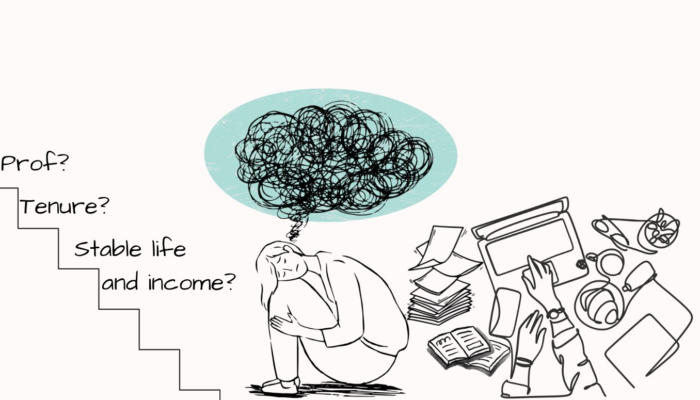
Hello, it’s us again! Coming back from the holidays, there couldn’t be a more fitting way to kick off a new blog season than by delving into the world of postdocs or to put it more precisely, by stepping into the shoes of a postdoc. As we try to reacquaint ourselves with our daily routines, I think it’s a perfect moment to empathise with those navigating postdoctoral life’s unique challenges.
Postdoctoral researchers are the unsung heroes of the academic world, bridging the gap between graduate studies and independent research careers. They play a pivotal role in advancing scientific knowledge, yet their contributions often come at a high personal cost. As you might remember, last year we talked about the origin of Postdoc Appreciation Week; and what being a postdoc means; and we introduced a little, small-scale “survey” to listen to the postdocs in geodesy and other geosciences. In this blog post, we try to shed light on the challenges of postdocs by merging our survey results with some studies.
The shortcomings of short-term contracts
Postdoc contracts vary a lot in their length; often lasting 1 to 3 years, or sometimes less than a year, but if you are lucky you can find something that lasts for 5 years. The short-term contracts create an uncertain environment, making it difficult for them to plan for the future. It affects various aspects of a postdoc’s life, from personal relationships to career aspirations. There is the pressure that is both internal and external with unrealistic expectations: the number of publications you need to have in that 1 or 2-year-long research period, finalising the papers from your PhD along with your long to-do list that you have, finishing that odd job you discussed with your PI that they keep mentioning, writing grant applications to secure an extension of your contract and so on. You know what? Iris van Zelst explains it better than I can do here.
Life on the move
Mobility has been an expectation or a requirement in academia for a long time, especially when securing a permanent position. In recent years, these expectations started affecting early career scientists; especially postdocs (Nikunen and Lempiäinen, 2020). A study highlights that mobility levels tend to peak between the ages of 25 and 40, with a rapid decline after the age of 41 (European Commission, 2008; Vohlídalová 2014). It’s important to highlight that the impact of mobility is not uniform across all demographics. For instance, single men and women generally exhibit similar mobility rates, however, when it comes to married individuals, there’s a noticeable gender difference, with married women being less mobile than their male counterparts (Moguérou, 2004). In addition to the gender gap, this sort of inequality is visible for researchers with visa restrictions (e.g. third-country nationals).
…mobility levels tend to peak between the ages of 25 and 40, with a rapid decline after the age of 41… single men and women generally exhibit similar mobility rates, however, when it comes to married individuals, there’s a noticeable gender difference
The ripple effect
Various studies underscore the tremendous difficulties that come with the academic mobility required for early career scientists (Schaer, 2022; Schittenhelm, 2022; Nikunen and Lempiäinen, 2020; Shinozaki, 2014). However, the challenges of academic mobility for early career scientists extend far beyond the individual postdoc. This mobility does not only affect them individually at a personal and professional level but also causes a ripple effect through their personal lives, affecting their partners and families. The constant need to uproot and relocate for short-term positions can strain relationships and disrupt family dynamics (Hardill, 2004; Shinozaki, 2014). For postdocs with partners pursuing their careers, it’s often a daunting challenge for the partner to adapt to the frequent job changes and geographic moves. For those with children, the challenges are even more pronounced. Children must adjust to new schools and environments regularly, which can impact their social and academic development. Additionally, finding stable and affordable childcare in different locations can be a logistical nightmare for postdocs.
In the realm of academic mobility, another layer of complexity is often overlooked: the experience of researchers who happen to be third-country nationals. These individuals often encounter a unique set of challenges, including visa restrictions and cumbersome bureaucratic hurdles (Shinozaki, 2014; Schaer, 2022). Imagine the difficulties of uprooting your life for a one- or two-year position, only to confront a maze of visa complications that could potentially disrupt your entire academic journey. If you have a family, these challenges can multiply exponentially. Moving a family, dealing with uncertain visa prospects, and navigating unfamiliar bureaucratic processes can turn the prospect of a short-term research opportunity into a daunting endeavour. These difficulties underscore the need for support and flexibility in academic mobility; ensuring that postdocs from all corners of the world can contribute to global research efforts without unnecessary impediments.
In the realm of academic mobility, another layer of complexity is often overlooked: the experience of researchers who happen to be third-country nationals.
As we explore the challenges of being a postdoc, it’s evident that the concept of academic mobility, once seen as a pathway to career growth, demands a more nuanced and supportive approach. While talking about these challenges, we also acknowledge the resilience and dedication of these individuals who continue to push the boundaries of human knowledge. It’s a reminder that pursuing science is not just a solitary endeavour; it’s a shared journey, one that requires empathy, understanding, and collective effort. So, as we celebrate Postdoc Appreciation Week, let’s not only applaud their academic achievements but also champion a more inclusive and compassionate academia, where mobility is a stepping stone rather than a stumbling block on the road to scientific discovery.
References
European Commission. (2008). Evidence on the main factors inhibiting mobility and career development of researchers. Brussels: EC. Retrieved from: http://ec.europa.eu/euraxess/pdf/ research_policies/rindicate_final_report_2008_11_june_08_v4.pdf)
Hardill, I. (2004). Transnational living and moving experiences: intensified mobility and dual‐career households. Population, Space and Place, 10(5), 375-389.
Moguérou, P. (2004). A double gender-family inequality phenomenon in the international mobility of young researchers. Research Institute on Education (IREDU).
Nikunen, M., & Lempiäinen, K. (2020). Gendered strategies of mobility and academic career. Gender and Education, 32(4), 554-571.
Schaer, M. (2022). From mobility attractiveness to mobility fatigue: The impact of repeated transnational mobility on the lives and aspirations of early‐career academics. Population, Space and Place, 28(5), e2536.
Shinozaki, K. (2014). Career Strategies and Spatial Mobility among Skilled Migrants in Germany: The Role of Gender in the Work‐Family Interaction. Tijdschrift voor economische en sociale geografie, 105(5), 526-541.
Schittenhelm, K. (2022). Negotiating unequal mobility opportunities: Young academics’ mobility in the EU and their partner-related living arrangements. Geoforum, 133, 117-127.
Vohlídalová, M. (2014). Academic mobility in the context of linked lives. Human Affairs, 24, 89-102.

